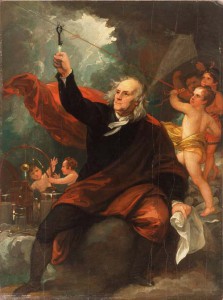Benjamin Franklin is known by many for being far ahead of his time. In the United States he founded the first hospital, the first insurance company, the first circulating library, the first fire department and the first police organization. He was the first postmaster in the U.S. and drew the first cartoon in an American newspaper.
 Given his track record, it’s probably no surprise that Franklin was also using key elements of the Six Sigma methodology hundreds of years before Six Sigma was a formally recognized discipline.
Given his track record, it’s probably no surprise that Franklin was also using key elements of the Six Sigma methodology hundreds of years before Six Sigma was a formally recognized discipline.
Franklin may be best known for providing the world a better understanding of electricity.
Before Franklin, people felt the power of electricity during lightning storms, but had no words or concepts to help them understand how it worked. Electricity had become a mysterious force that people feared because they viewed it with superstition. When storms approached, churches rang their bells at full force with the hope that loud noise would somehow scare away the lightning. If a house caught on fire from a lightning strike, neighbors would refuse to quench the flames thinking that the lightning was a higher power bringing judgment upon the wicked.
Franklin helped put an end to the superstition by applying his curiosity, practical experiments and patient mechanical skill to help unlock the mysteries of electricity and explain how it works.
Clarity Through the Power of Words
Franklin’s career as a journalist gave him the skill to use household words to explain complex concepts. He used common sense terms to help make the mystery of electricity understandable to the masses. Franklin coined the term electric charge and classified charges as positive and negative. Battery, neutral, condense, and conductor were all familiar words that Franklin put to new use to help explain the way electricity works.
The framework and terminology that Franklin brought to understanding the force of electricity was critical in helping later generations harness it and use it in ways that improve every aspect of our modern lives.
Six Sigma Terminology Brings Clarity
When the root causes of variance in a production process are not well understood, they can become a source of the same confusion and even superstition that once plagued electricity.
The discipline, rigor and clear thinking that Franklin brought to unlocking the mysteries of electricity are the same kind of qualities that Six Sigma project teams need. These qualities help teams to understand, explain and resolve the defects in a production process.
Six Sigma has some of the same tools at its disposal as Franklin did to make the unknown and mysterious into something clear and understandable.
Six Sigma is equipped with its own language to help demystify how a production process works or fails to work. A poorly understood process becomes less of a mystery when it is deconstructed and each element described in rich Six Sigma terms such as: common/special cause variation, baseline measurements, defect opportunity, non-value added activities and rolled throughput yield. Six Sigma’s vocabulary helps project teams and employees understand the process. This understanding helps the team improve process quality.
Six Sigma delivers more than just impressive sounding terms. It also contains a treasure trove of tools that help diagnose problems and implement solutions. Like Franklin’s work, Six Sigma methodology focuses on practical, quantifiable improvements.
